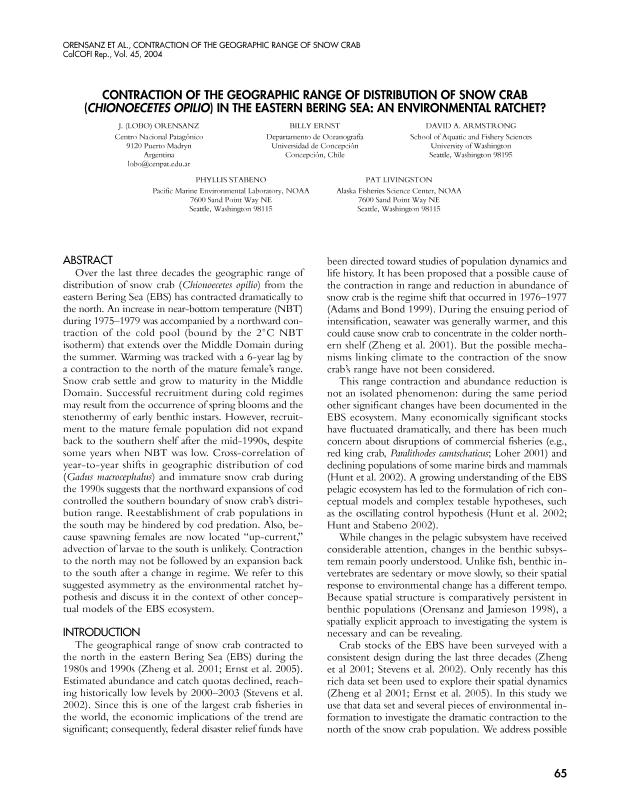Mostrar el registro sencillo del ítem
dc.contributor.author
Orensanz, Jose Maria

dc.contributor.author
Ernest, Billy
dc.contributor.author
Armstrong, David A.
dc.contributor.author
Stabeno, Phyllis
dc.contributor.author
Livingston, Pat
dc.date.available
2017-12-15T14:19:02Z
dc.date.issued
2005-08
dc.identifier.citation
Livingston, Pat; Stabeno, Phyllis; Armstrong, David A.; Ernest, Billy; Orensanz, Jose Maria; Contraction of the geographic range of distribution of snow crab (Chionoecetes opilio) in the eastern Bering Sea: An environmental ratchet?; Scripps Institution of Oceanography; California Cooperative Oceanic Fisheries Investigations Reports; 45; 8-2005; 65-79
dc.identifier.issn
0575-3317
dc.identifier.uri
http://hdl.handle.net/11336/30732
dc.description.abstract
Over the last three decades the geographic range of distribution of snow crab (Chionoecetes opilio) from the eastern Bering Sea (EBS) has contracted dramatically to the north. An increase in near-bottom temperature (NBT) during 1975–1979 was accompanied by a northward contraction of the cold pool (bound by the 2°C NBT isotherm) that extends over the Middle Domain during the summer. Warming was tracked with a 6-year lag by a contraction to the north of the mature female's range. Snow crab settle and grow to maturity in the Middle Domain. Successful recruitment during cold regimes may result from the occurrence of spring blooms and the stenothermy of early benthic instars. However, recruitment to the mature female population did not expand back to the southern shelf after the mid-1990s, despite some years when NBT was low. Cross-correlation of year-to-year shifts in geographic distribution of cod (Gadus macrocephalus) and immature snow crab during the 1990s suggests that the northward expansions of cod controlled the southern boundary of snow crab’s distribution range. Reestablishment of crab populations in the south may be hindered by cod predation. Also, because spawning females are now located “up-current,” advection of larvae to the south is unlikely. Contraction to the north may not be followed by an expansion back to the south after a change in regime. We refer to this suggested asymmetry as the environmental ratchet hypothesis and discuss it in the context of other conceptual models of the EBS ecosystem.
dc.format
application/pdf
dc.language.iso
eng
dc.publisher
Scripps Institution of Oceanography
dc.rights
info:eu-repo/semantics/openAccess
dc.rights.uri
https://creativecommons.org/licenses/by-nc-sa/2.5/ar/
dc.subject.classification
Otras Ciencias Biológicas

dc.subject.classification
Ciencias Biológicas

dc.subject.classification
CIENCIAS NATURALES Y EXACTAS

dc.title
Contraction of the geographic range of distribution of snow crab (Chionoecetes opilio) in the eastern Bering Sea: An environmental ratchet?
dc.type
info:eu-repo/semantics/article
dc.type
info:ar-repo/semantics/artículo
dc.type
info:eu-repo/semantics/publishedVersion
dc.date.updated
2017-11-24T14:32:59Z
dc.journal.volume
45
dc.journal.pagination
65-79
dc.journal.pais
Estados Unidos

dc.journal.ciudad
California
dc.description.fil
Fil: Orensanz, Jose Maria. Consejo Nacional de Investigaciones Científicas y Técnicas. Centro Científico Tecnológico Conicet - Centro Nacional Patagónico; Argentina. Consejo Nacional de Investigaciones Científicas y Técnicas; Argentina
dc.description.fil
Fil: Ernest, Billy. Universidad de Concepción; Chile
dc.description.fil
Fil: Armstrong, David A.. University of Washington; Estados Unidos
dc.description.fil
Fil: Stabeno, Phyllis. Pacific Marine Environmental Laboratory; Estados Unidos
dc.description.fil
Fil: Livingston, Pat. National Ocean And Atmospheric Administration. Alaska Fisheries Science Center; Estados Unidos
dc.journal.title
California Cooperative Oceanic Fisheries Investigations Reports

dc.relation.alternativeid
info:eu-repo/semantics/altIdentifier/url/http://www.calcofi.org/publications/calcofireports/v45/CalCOFI_Rpt_Vol_45_2004.pdf
Archivos asociados
